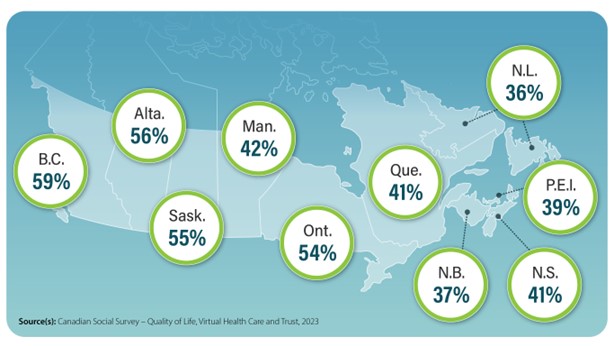
The world is moving increasingly online and so too are Canadians when it comes to health care. Having access to electronic health information may allow patients to be more informed about and better manage their health. In the summer of 2023, just over half of Canadians (51%) aged 15 and older living in the provinces reported accessing electronic health information in the past 12 months. The reasons for accessing information included getting lab test results, vaccine or immunization records, upcoming appointments, current medications and medication history, and medical imaging reports.
Understanding the reasons why Canadians do or do not use electronic health information, and whether they do so by age, gender, and other characteristics can potentially help reduce barriers and improve access.
Canadians with a regular health care provider, those living with a chronic condition, and women were more likely to access electronic health information
Canadians with a regular health care provider (55%) were more likely to access electronic health information than those who did not have one (36%). In addition, Canadians with a chronic condition (56%) were more likely to access health records than those without a chronic condition (46%).
A higher proportion of women (55%) reported accessing at least one type of electronic health information than men (46%). While half of adults younger than 65 years of age (52%) reported accessing health information online, a lower proportion of older adults aged 65 and older (47%) reported doing the same.
Lab test results and vaccine or immunization records were the most common reasons to access online health information
Electronic health information accessed by Canadians was provided by family doctors, general practitioners, or nurse practitioners (61%), followed by laboratories (38%) and medical specialists (18%).
When we asked those who accessed electronic health information in the past 12 months, some of the reasons cited for accessing this information included getting lab test results (60%), vaccine or immunization records (47%), confirming upcoming appointments (31%) and accessing current medications and medication history (27%).
Most types of electronic health information were accessible at no cost. However, 16% of those who viewed their current medications and medication history reported having to pay for access, 14% paid to view their medical imaging reports, and 13% paid to view their lab test results.
Map 1: More than half of residents of British Columbia, Alberta, Saskatchewan and Ontario reported accessing electronic health information

Description - More than half of residents of British Columbia, Alberta, Saskatchewan, and Ontario reported accessing electronic health information
Map description:
The title of the map is "More than half of residents of British Columbia, Alberta, Saskatchewan and Ontario reported accessing electronic health information"
This is a map of Canada by province showing the share of Canadians who reported accessing electronic health information in 2023.
The share of people who reported accessing electronic health information in Newfoundland and Labrador was 36%.
The share of people who reported accessing electronic health information in Prince Edward Island was 39%.
The share of people who reported accessing electronic health information in Nova Scotia was 41%.
The share of people who reported accessing electronic health information in New Brunswick was 37%.
The share of people who reported accessing electronic health information in Quebec was 41%.
The share of people who reported accessing electronic health information in Ontario was 54%.
The share of people who reported accessing electronic health information in Manitoba was 42%.
The share of people who reported accessing electronic health information in Saskatchewan was 55%.
The share of people who reported accessing electronic health information in Alberta was 56%.
The share of people who reported accessing electronic health information in British Columbia was 59%.
Source(s): Canadian Social Survey, Quality of Life, Virtual Health Care and Trust, 2023.
Why Canadians don’t access health records online
There are various reasons why nearly half of Canadians don’t access their electronic health information online, with over one-third of this group not doing so because they are not interested in accessing their electronic health information (37%). About one-quarter reported being unaware of the existence of electronic health information (27%), while 9% indicated that their health care professional does not provide electronic health information. Meanwhile, one in ten (10%) cited not being comfortable with technology, 6% indicated they do not have access to required technology, and 3% cited privacy and security as a reason for not accessing health information electronically.
Note to readers
This release is based on data from the Canadian Social Survey (CSS): Quality of Life, Virtual Health Care and Trust, collected from July 14 to September 7, 2023. The CSS collects information from individuals and families on quality of life, virtual health care and trust in media. Results from the survey will help decision makers develop programs and policies to better serve Canadians.
The CSS aims to better understand social issues rapidly by conducting surveys on different topics every three months. Statistics Canada would like to thank all Canadians who took the time to answer the questions.
For more information, refer to the Statistics Canada survey information page: Canadian Social Survey.
In this release, the term "Canadians" refers to residents of Canada, regardless of citizenship status.
Electronic health information may be provided by hospitals, doctors, laboratories, pharmacies, or other health professionals. It may include the following information: lab test results, vaccine or immunization records, current medications and medication history, patient visit summaries, specialist consultation notes or records, upcoming appointments, forms and questionnaires, progress notes, discharge summaries, medical imaging reports and other electronic health information.
This article does not disaggregate data for the following groups: immigration status, visible minority group, Indigenous identity, persons with a disability, difficulty or long-term condition, LGBTQ2+, main activity as well as urban and rural areas. Further analysis is possible in the future.
StatsCAN app
Did you know you can read StatsCAN Plus articles and more on the StatsCAN app? If you’re already using the app, let us know what you think by leaving a review in the App Store and Google Play.
Contact information
For more information, contact the Statistical Information Service (toll-free 1-800-263-1136; 514-283-8300; infostats@statcan.gc.ca) or Media Relations (statcan.mediahotline-ligneinfomedias.statcan@statcan.gc.ca).
